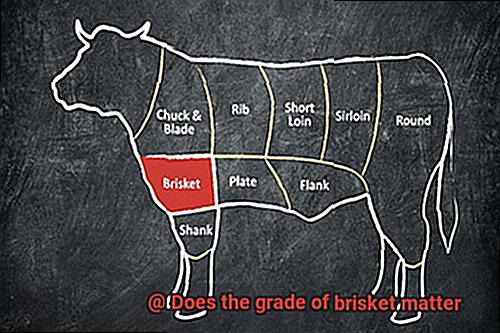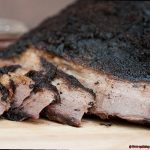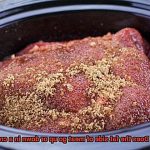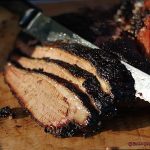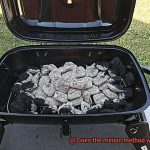Are you a self-proclaimed brisket aficionado, constantly on the lookout for the perfect cut? Do you crave that juicy, succulent flavor that only a perfectly cooked brisket can provide? If so, then you’ve probably wondered whether the grade of brisket matters and how it affects the final outcome. Well, get ready to learn something new.
Brisket is a beloved cut of beef that requires low and slow cooking to achieve its tender texture and bold taste. It’s classified into different grades, ranging from Prime to Select, each with unique qualities that impact the meat’s flavor and tenderness. But does the grade of brisket really make a difference when it comes to cooking and enjoying it?
In this blog post, we’ll take a deep dive into the various grades of brisket, what they signify, and how they affect your cooking process. We’ll also explore the differences in taste and texture between each grade, helping you determine which one is ideal for your specific needs. Whether you’re an amateur cook or an experienced pitmaster, understanding the nuances of each grade can help take your barbecue game to new heights.
So grab your apron and get ready for a tantalizing journey as we uncover whether the grade of brisket truly matters and how it impacts your barbecuing prowess.
Contents
The Three Grades of Beef
The grade of beef is determined by its age, marbling, and muscle development. However, when it comes to brisket, the grade of beef can make a big difference in terms of flavor and tenderness.
Prime beef is the crème de la crème of beef cuts. It has the most marbling and tenderness and is often used by high-end restaurants and butchers. This grade can be difficult to find in grocery stores, but when it comes to brisket, prime brisket is undoubtedly the best option. It’s packed with marbling that keeps it moist and flavorful during cooking.
But prime brisket can also be quite expensive and may not fit into everyone’s budget. This is where Choice brisket comes in; it’s the perfect balance between quality and affordability. Choice brisket has less marbling than prime but still retains enough to make it tender and rich in flavor when cooked properly.
For those on a tight budget or prefer a leaner cut of meat, Select brisket is an excellent option. However, this grade of beef has less marbling than choice or prime, making it tougher. To make it tender and delicious, a longer cooking time and more seasoning like a marinade or wrapping in foil are required.
When it comes to grilling brisket, different grades of brisket are better suited for different cooking methods and preferences. Here are some things to keep in mind:
- Prime brisket is best for smoking and slow-cooking methods because it benefits from added moisture like a marinade or wrapping in foil.
- Choice brisket is ideal for those who want a good balance of tenderness and affordability. It requires less cooking time than select but still has enough marbling to make it juicy and delicious.
- Select brisket is the leanest cut of beef, making it ideal for those who prefer a healthier option. However, it requires the longest cooking time and needs to be seasoned well to bring out its flavor.
Why Does the Grade of Brisket Matter?
As a true BBQ connoisseur, you know that the perfect brisket requires more than just throwing meat on a grill. It’s an art form that requires passion, dedication, and a keen eye for detail. And when it comes to achieving that perfect brisket, the grade of meat you choose can make or break your masterpiece.
So why does the grade of brisket matter? Let’s dive deeper into this crucial decision.
Firstly, there are three grades of beef, each with its unique characteristics. Prime is the crème de la crème, with the most marbling and tenderness. Choice falls in the middle, offering a balance of quality and affordability, while select is leaner and requires more attention to achieve flavor.
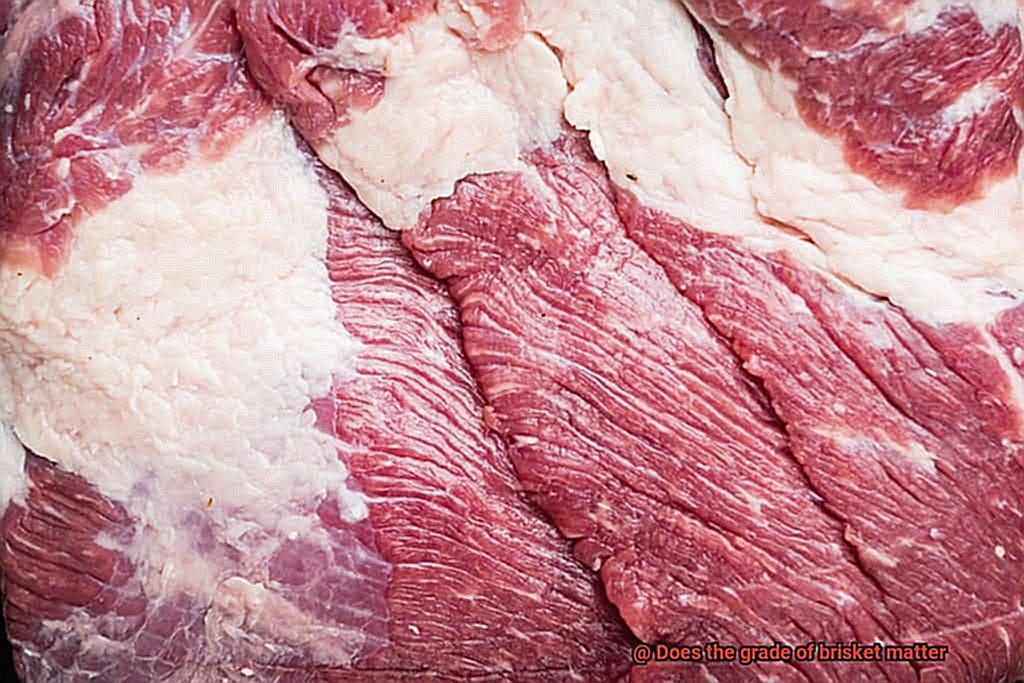
Now let’s discuss why this matters for your brisket.
- Flavor: The grade of beef directly affects the taste of your brisket. Prime beef boasts the most marbling, which leads to more fat content, resulting in a richer, beefier flavor. However, choice and select grades can still offer great flavor with proper cooking techniques.
- Tenderness: Marbling also plays a crucial role in the tenderness of your brisket. The fat melts during cooking, keeping the meat moist and tender. Prime grade beef has the most marbling and tenderness, while choice and select can still be tender with proper preparation.
- Cooking time: Select grade brisket is leaner than prime or choice, meaning it takes longer to break down the tougher muscle fibers and become tender. This can be challenging for beginners but achievable with patience and practice.
- Cost: Budget plays a role in selecting the grade of your brisket. Prime is the most expensive, while choice and select offer more affordable options without sacrificing too much quality.
But selecting the right grade isn’t the only factor in achieving a mouth-watering brisket. Cooking techniques such as seasoning, smoking, wrapping, and resting are just as crucial to the final product.
Prime Brisket: The Best Option
Look no further than prime brisket – the crème de la crème of beef. As an expert on this topic, I can attest that prime brisket is the best option for creating a mouth-watering masterpiece that will impress even the most discerning taste buds.
Why is prime brisket the top choice? First and foremost, we must discuss marbling. Marbling is the small flecks of fat that are dispersed throughout the meat, adding flavor and juiciness. Prime brisket boasts a higher degree of marbling compared to other grades of beef, resulting in a melt-in-your-mouth texture and an explosion of flavor in every bite.
Consistency in quality is another reason why prime brisket reigns supreme. Sourced from young, well-fed cattle, prime brisket is less variable in terms of texture and flavor. Thus, you can feel confident in your cooking, knowing that you are starting with a top-notch cut of beef every time.
Now, some may argue that prime brisket’s price tag may deter them from investing in it. It is true that prime brisket can be more expensive than other cuts of beef, but trust us when we say it’s worth it. The exceptional taste and tenderness of the meat make it worth every penny. Plus, if you’re entertaining a crowd, investing in prime brisket will leave an unforgettable impression on your guests.
Choice Brisket: A More Affordable Option
While Prime Brisket may be the crème de la crème of beef, this delicious cut can come with a hefty price tag. Luckily, Choice Brisket is an excellent alternative that still offers plenty of flavor and tenderness.
Let’s start by breaking down the different grades of beef. Prime is the highest grade and is sourced from young cattle with abundant marbling. While it’s known for its tenderness and flavor, it can be expensive. Choice Brisket, on the other hand, comes from slightly older cattle with less marbling. But don’t be fooled; this cut still packs a punch when it comes to taste.
One of the benefits of choosing Choice Brisket is its robust beef flavor that can hold up well to long cooking times. Many pitmasters prefer this cut because it still maintains its taste even after hours of smoking or grilling. Another trick to keep in mind when selecting your Choice Brisket is to look for cuts with a good amount of fat on them. The fat renders down during cooking, keeping the meat moist, and adding flavor.
To make the most out of your Choice Brisket, it’s worth consulting with your local butcher for recommendations on which cuts to choose. They are experts in their field and can guide you towards cuts that are more likely to be tender and flavorful.
Now, why opt for Choice Brisket over Prime? For starters, it’s more budget-friendly, making it an excellent option for those who want to enjoy a tasty meal without breaking the bank. With some careful preparation and selection, you can create a delicious brisket that will impress your guests.
Select Brisket: Leaner and Suitable for Smoking or Slow Cooking
Let’s start with Prime grade beef, the crème de la crème of beef quality. This grade comes from younger, well-fed, and well-exercised cattle, resulting in abundant marbling throughout the meat. The marbling makes prime grade beef tender, juicy, and packed with flavor. However, this quality comes at a cost – prime grade beef is expensive and can be hard to find.
Next up is Choice grade beef, another high-quality option that has less marbling than prime but is still tender and flavorful. It may require some extra seasoning or cooking techniques to achieve the desired result.
Lastly, we have Select grade beef, which is leaner with less marbling than prime or choice. This type of beef is ideal for dishes that require slow cooking or smoking since it can become tender over time. However, it may lack the intense flavor and juiciness of higher-grade meats.
When selecting brisket for smoking or slow cooking, it’s crucial to consider your desired outcome and cooking method. If you’re looking for a tender and flavorful brisket with abundant marbling, prime or choice grade brisket may be your best bet. On the other hand, if you prefer a leaner cut that becomes tender over time through low-heat cooking, select grade brisket is a great option.
To sum up, the grade of brisket you choose will significantly impact your final dish’s flavor and tenderness. Don’t forget to consider your budget and cooking method when making your selection. And if you’re still not sure which type of beef to choose, don’t hesitate to ask your local butcher for their expert recommendations – they’re always happy to help.
Tips for Choosing the Right Grade of Brisket
When it comes to preparing the perfect brisket, choosing the right grade of beef is crucial. The grade of brisket refers to the quality and tenderness of the meat, which can greatly impact the taste and texture of your final product. Here are some factors to consider when selecting the ideal grade of brisket for your needs:
Quality Grades
The three grades of brisket that you will typically come across are Select, Choice, and Prime. Select is the lowest grade, with less marbling and tenderness than the other two grades. Choice is a step up from Select, with more marbling and tenderness, while Prime is the highest grade with the most marbling and tenderness.
Budget
While Prime may seem like the obvious choice for the best brisket, it can be expensive and harder to find. Therefore, it is important to consider your budget when selecting a grade of brisket.
Cooking Method
Consider how you plan on cooking your brisket. If you’re planning on smoking your brisket low and slow for several hours, then a higher grade with more marbling may be beneficial to prevent the meat from drying out. On the other hand, if you’re planning on grilling your brisket quickly over high heat, then a leaner cut may be more appropriate.
Personal Preference
The grade of brisket you choose should ultimately depend on your personal preference and taste preferences. Some pitmasters prefer a leaner cut of meat for a different texture and flavor profile.
Flexibility
Finally, it’s important to remember that not every situation will call for the highest quality meat. If prime grade brisket is unavailable or outside your budget, don’t be afraid to try a different grade or experiment with different cooking methods to achieve the desired tenderness and flavor.
Different Cooking Methods for Different Grades of Brisket
As a seasoned brisket expert, I’m here to guide you through the ins and outs of cooking different grades of this savory cut.
First up, let’s talk about Select brisket. This is the lowest grade and can be tough and lean. The best way to cook this cut is through moist heat methods like braising or slow cooking in a crockpot. These methods help break down the tough fibers and make the meat more tender, while also keeping it from drying out.
- Next on the list is Choice brisket – the most commonly found grade in grocery stores. It boasts more marbling than Select, making it more flavorful and tender. You can cook it using various techniques like smoking, grilling, or roasting. However, if you want to preserve its tenderness and flavor, smoking is the way to go.
- Finally, there’s Prime brisket – the highest grade with the most marbling, making it the most tender and flavorful of all. To enjoy its natural richness to the fullest, slow cooking using a smoker or slow cooker is ideal. This cooking method helps break down the fat and connective tissue, resulting in a melt-in-your-mouth texture that will leave you wanting more.
Remember that no matter which grade of brisket you choose, proper cooking techniques are crucial for achieving optimal results. Be patient, take your time, and enjoy the process of creating a delectable meal for yourself and your loved ones.
P3PFTgclZdY” >
Conclusion
In conclusion, the grade of brisket is a crucial factor to consider when preparing this mouthwatering beef cut. The three grades of beef – Prime, Choice, and Select – each offer distinct qualities that can affect the taste and texture of your brisket. Prime brisket reigns supreme with its abundant marbling that keeps it juicy and packed with flavor, but it can come at a hefty price tag. On the other hand, Choice brisket strikes an excellent balance between quality and affordability, while Select brisket requires more attention to achieve optimal taste due to its leaner composition.
To pick the perfect grade of brisket for your needs, take into account various factors such as your budget, cooking method, personal preference, and flexibility. If you plan on smoking your brisket low and slow for hours on end, then opting for a higher-grade cut with more marbling might be ideal to prevent dryness.
But no matter which grade you choose, mastering proper cooking techniques is essential for achieving outstanding results. So be sure to take your time and enjoy the process of creating a delectable meal for yourself and loved ones.

